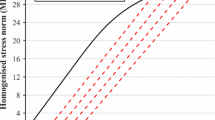Abstract
Motivated by applications in orthopaedic and maxillo-facial surgery, the mechanical behaviour of cortical bone in cyclic overloads at physiological strain rates is investigated. To this end, a new one-dimensional rate-independent constitutive model for compact bone is proposed to simulate the damage accumulation occurring during tensile or compressive overloading. We adopted a macroscopic and phenomenological description of the mechanics of cortical bone. The mathematical formulation of the model is established within the framework of generalized standard materials and is based on the definition of three internal state variables: a tensile and a compressive damage variable that represent the microcrack density and a residual strain variable that represents the permanent strain associated with the sliding behaviour of these microcracks. Distinct damage threshold stresses are used in tension and compression. As the macroscopic mechanical behaviour of bovine cortical bone is very similar to that of human cortical bone and of much easier access, we first achieved the validation and identification of the material constants of the constitutive laws in tension using new uniaxial experimental results of bovine compact bone of our own. With adequate original hardening rules, the constitutive model is able to reproduce the main features of cortical bone behaviour under arbitrary cyclic tensile and compressive loadings. The proposed algorithm applies for the first time three distinct projections based on the relationship between the three internal variables and criteria. The predicted stress–strain curves exhibit a damaged reloading which is collinear with the origin as many cyclic overloading experiments on cortical bone have shown. Note that as our model was identified for physiological strain rates, it hardly can be applied in high strain rate situations like the ones involved in impact studies.
Similar content being viewed by others
References
Alart P., Curnier A.: A mixed formulation for frictional contact problems prone to Newton like solution methods. Comput. Methods Appl. Mech. Eng. 92, 353–375 (1991)
Ascenzi A., Bonucci E., Ripamonti A., Roveri N.: X-ray diffraction and electron microscope study of osteons during calcification. Calcif. Tiss. Res. 25, 133–143 (1978)
Cowin S.C.: Bone Mechanics. CRC Press, Boca Raton (1989)
Curnier, A.: Méthodes numériques en mécanique des solides. Presses Polytechniques et Universitaires Romandes (PPUR), Lausanne (1993)
Fondrk M.T., Bahniuk E.H., Davy D.T.: A damage model for nonlinear tensile behavior of cortical bone. J. Biomed. Eng. 121, 533–541 (1999)
Fondrk M.T., Bahniuk E.H., Davy D.T.: Inelastic strain accumulation in cortical bone during rapid transient tensile loading. J. Biomech. Eng. 121, 616–621 (1999)
Fondrk M.T., Bahniuk E.H., Davy D.T., Michaels C.: Some viscoplastic characteristics of bovine and human cortical bone. J. Biomech. 21(8), 623–630 (1988)
Garcia, D.: Elastic plastic damage constitutive laws for cortical bone. Ph.D. Thesis. http://library.epfl.ch/theses/?nr=3435 (2006)
Garcia D., Zysset P.K., Charlebois M., Curnier A.: A three-dimensional elastic plastic damage constitutive law for bone tissue. Biomech. Model. Mechanobiol. 8(4), 149–165 (2009)
Keaveny T.M., Wachtel E.F., Kopperdahl D.L.: Mechanical behavior of human trabecular bone after overloading. J. Orthop. Res. 17, 346–353 (1999)
Kotha S.P., Guzelsu N.: Tensile damage and its effects on cortical bone. J. Biomech. 36(11), 1683–1689 (2003)
Lemaitre J.: A Course on Damage Mechanics, 2nd edn. Springer, New York (1996)
McElhaney J.H.: Dynamic response of bone and muscle tissue. J. Appl. Physiol. 21, 1231–1236 (1966)
Moreau J.J.: Application of convex analysis to some problems of dry friction. In: Zorski, H. (eds) Trends in Applications of Pure Mathematics to Mechanics II, pp. 263–280. Pitman, London (1979)
Ortiz M.: A constitutive theory for the inelastic behavior of concrete. Mech. Mater. 4(1), 67–93 (1985)
Reilly D.T., Burstein A.H.: The elastic and ultimate properties of compact bone tissue. J. Biomech. 8(6), 393–396 (1975)
Simo J.C., Hughes T.J.R.: Computational Inelasticity. Springer, Berlin (1999)
Wilkins M.L.: Calculation of elastic-plastic flow. Methods Comput. Phys. 3, 211–263 (1964)
Ziegler H.: An Introduction to Thermomechanics, 2nd edn. North-Holland Publishing Company, Amsterdam (1983)
Zysset, P.: A constitutive law for trabecular bone. Ph.D. Thesis, Ecole Polytechnique Fédérale de Lausanne (EPFL), Lausanne (1994)
Author information
Authors and Affiliations
Corresponding author
Rights and permissions
About this article
Cite this article
Garcia, D., Zysset, P.K., Charlebois, M. et al. A 1D elastic plastic damage constitutive law for bone tissue. Arch Appl Mech 80, 543–555 (2010). https://doi.org/10.1007/s00419-009-0382-2
Received:
Accepted:
Published:
Issue Date:
DOI: https://doi.org/10.1007/s00419-009-0382-2




